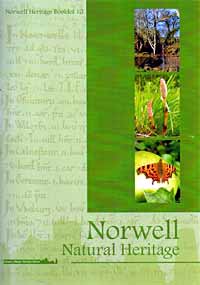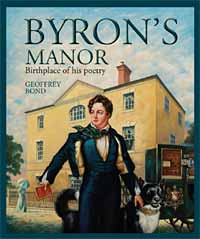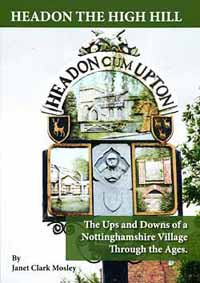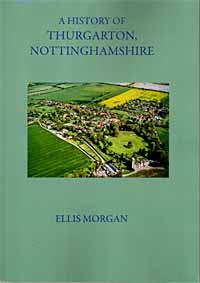Book and article reviews, Summer 2025
Norwell : Natural Heritage by Elizabeth Jones
Norwell Parish Heritage Group, ISSN 2040-2406, 85 figures, 64pp
 Norwell Natural Heritage by Elizabeth Jones is the tenth booklet in the remarkable series Norwell Heritage, which has been researched, written and published by the Norwell Parish Heritage Group since its foundation in 2006. The booklet, like others in the series, makes use of a diverse range of sources including oral histories, observation of the landscape, flora and fauna of the Parish, and careful examination and interpretation of historical sources and
maps. The historical sources include The White Book of Southwell (Liber Albus) which provides field names, the currently unpublished ‘Town Book’ of Norwell, which gives much information on the activities of village officers in the seventeenth and eighteenth centuries with ‘passing references to stones, trees, water and animals’ (p49) and the fascinating logbooks of Norwell Church School. The booklet is beautifully produced and includes over eighty carefully selected colour photographs.
Norwell Natural Heritage by Elizabeth Jones is the tenth booklet in the remarkable series Norwell Heritage, which has been researched, written and published by the Norwell Parish Heritage Group since its foundation in 2006. The booklet, like others in the series, makes use of a diverse range of sources including oral histories, observation of the landscape, flora and fauna of the Parish, and careful examination and interpretation of historical sources and
maps. The historical sources include The White Book of Southwell (Liber Albus) which provides field names, the currently unpublished ‘Town Book’ of Norwell, which gives much information on the activities of village officers in the seventeenth and eighteenth centuries with ‘passing references to stones, trees, water and animals’ (p49) and the fascinating logbooks of Norwell Church School. The booklet is beautifully produced and includes over eighty carefully selected colour photographs.
The booklet shows how human activities over many centuries are closely interconnected to the natural world of rocks, plants and animals. Elizabeth Jones points out that the ‘loss of biodiversity, climate change, increased flooding and other natural disasters all threaten the future’ and that the ‘natural world must not be ignored’ (p.5). Following the introduction, the booklet has chapters on the Physical Heritage, including geology and water, the Landscape, with a focus on field patterns, enclosure and field names, and the Living Heritage, with sections on woods and trees, hedgerows and flora and fauna. The coverage is comprehensive and includes an excellent balance of detailed examples and more general assessments of natural heritage. There are several specific panels which provide detailed information on some key themes and places: Moats and Fishponds, Swinney Wood, Park Wood, Brewing in Norwell, Dovecotes, Pigeons and Manure, and Bees and Beekeeping. Elizabeth Jones emphasises that most of Norwell Parish was owned by the church for nearly a thousand years and that rents from houses and land financed three Canons (prebendaries) of Southwell Minster. Church officials frequently figure in the historical record. In 1220, for example, ‘Alan de Ripon, prebendary of Norwell Palishall, gave 3 acres (1.2 hectares) of land to Simon de Hougrave’ and woodland was cleared (p.22).
In 1530 William Sturtevant of Palishall was allowed annually twelve loads of firewood and twenty loads of thorns for fencing as long as none of the oak trees growing in the woods were felled (p.23).
As late as the early twentieth century standard leases included a clause ‘reserving to the prebendary and successors all oak, ash and elm trees now standing or growing or hereafter to stand or grow with rights to cut down and collect timber.’ (p.24).
The section on flora and fauna contains rich material on the close connection between children and local plants and animals. The records of the Church School show that gardening classes were started in 1913, and nature walks were popular with pupils. In 1912 the HMI report for Norwell School had Nature Study as a focus, and the school was commended for the pupils’ books of pressed flowers and written descriptions.
As late as the 1950s the Annual Feast and Flower Show had a children’s class ‘for the collection of the most wildflowers in a ‘jam jar’ with a first prize of five shillings (p31). Such local knowledge is discussed together with the list of plant species in Norwell Parish recorded by Professor John Wesley Carr in c1906. Elisabeth Jones with Norwell Natural Heritage has produced a magnificent addition to the series of Norwell Heritage Booklets. It is a model of how Parish histories can include full consideration of the natural world and should help to ensure that emphasis is placed on nature and landscape conservation as the village develops in the future.
Charles Watkins
Bryon’s Manor, Birthplace of the Poet by Geoffrey Bond
 Geoffrey Bond is a ‘Byronist’ but not a conventional one. He is by career a lawyer and his three books (so far) have covered aspects of the poet’s life to which Byronists (students of the poet’s work) pay limited reference. These covered his dogs, his portraits, and now his manor which means, in effect, Burgage Manor, Geoffrey’s home
for the last 33 years. The key finding is that after years up in Aberdeen, Byron and his mother travelled south to claim young Byron’s inheritance. It was quickly clear that Newstead Abbey was too dilapidated to be a comfortable home, so Mrs Bryon took a lease of what was then the almost new Burgage Manor. Byron was expected to live there, but for much of the period 1803 to 1808 he was away for one reason or another. But crucially, when he was in Southwell, he wrote and published his first four books of poetry. It was, Geoffrey argues, at Southwell where Bryon’s first published poems originated.
Geoffrey Bond is a ‘Byronist’ but not a conventional one. He is by career a lawyer and his three books (so far) have covered aspects of the poet’s life to which Byronists (students of the poet’s work) pay limited reference. These covered his dogs, his portraits, and now his manor which means, in effect, Burgage Manor, Geoffrey’s home
for the last 33 years. The key finding is that after years up in Aberdeen, Byron and his mother travelled south to claim young Byron’s inheritance. It was quickly clear that Newstead Abbey was too dilapidated to be a comfortable home, so Mrs Bryon took a lease of what was then the almost new Burgage Manor. Byron was expected to live there, but for much of the period 1803 to 1808 he was away for one reason or another. But crucially, when he was in Southwell, he wrote and published his first four books of poetry. It was, Geoffrey argues, at Southwell where Bryon’s first published poems originated.
It was also a period when he developed a friendship with Elizabeth Pigot, who lived across the Green. After 1808 Byron persuaded his mother to move into Newstead Abbey and to run the property while he travelled across Europe. On his return he lived partly in Newstead, partly in London, and from 1816 in various parts of Europe until his death in 1824. He is buried in St Mary’s Church, Hucknall. When Geoffrey Bond moved into Burgage Manor, in his words, ‘there was nothing in the house to indicate that Byron had ever been there’. He has assembled, a splendid collection of books, papers and other Byron memorabilia including portraits. There are around 1,400 books. Geoffrey has life membership of the Thoroton Society and has donated considerable sums towards supporting research. On a number of occasions, he has invited members of the Society to visit both his house and gardens. He spoke to the Society at the Annual Lunch in November 2024. This is a lovely book to own. It is well written and beautifully illustrated.
Of course Byron spent only a very short time in residence at Burgage Manor, although it was long enough for him to negotiate with publishers and to write his early poetry, but Geoffrey has taken the opportunity to write not just about Byron and his mother, who vacated the house when Byron went abroad, leaving her to move to Newstead and run the estate, but also he has written about Southwell and other places associated with Byron including Aberdeen, Nottingham, Harrow (where Bryon attended school), Cambridge, Rochdale, London, numerous places in Italy and elsewhere. However, the emphasis throughout is on Byron and his links to Southwell. Another splendid book Geoffrey, is there another to come?
John Beckett
Headon on the Hill: The Ups and Downs of a Nottinghamshire Village Through the Ages by Janet Clark Mosley
 Dedicated to the people, past and present, who have lived in the village of Headon. (The author also acknowledges the help from the Nottinghamshire Local History Association.)
Dedicated to the people, past and present, who have lived in the village of Headon. (The author also acknowledges the help from the Nottinghamshire Local History Association.)
The author’s foreword to this book includes a detailed page on her interest and research into the village. She also points out that because the history of Upton and the village of Grove is often intertwined with Headon, there are references to these villages, but this book is specifically on Headon.
It is a most useful introduction to her research into the village. As she puts it, as the final sentence of this foreword: ‘Who would have thought that our quiet little village was once the setting of marauding armies, murderous henchmen and at one time saw a 900% increase in the population?’ This foreword really wets the appetite for the reader to read further and the book that follows is well set out, covering ‘The History of the Village’ from the Stone Age up to the present day.
This is a great village history and one of the best I have read in years, The first part of the book covers the earliest times giving the reader a wider picture, while the late chapters are more specific about the village history. As Janet writes on the back cover ‘Exploring its history has revealed some remarkable events which have helped to shape our village.’
All the chapters are full of historical information with illustrations. This allows the reader a full history of the village revealing remarkable events that helped shape the village and which aid readers to understand how history can shape a village.
A very well-researched and resourced book on the history of Headon which will not only be of interest to the local population but also to Nottingham and East Midland historians.
An incredibly detailed but very enjoyable read about a village throughout its historical journey. As the author says on the back cover about the book: ‘Exploring the history has revealed some remarkable events which have helped to shape our village.’
Paul Baker
A History of Thurgarton, Nottinghamshire, Ellis Morgan
 This epic and handsome volume of four hundred pages covers not only Thurgarton but sets out the history of the whole locality over many centuries as well. It also includes verbal, written and visual information from a wide number of Thurgarton residents.
This epic and handsome volume of four hundred pages covers not only Thurgarton but sets out the history of the whole locality over many centuries as well. It also includes verbal, written and visual information from a wide number of Thurgarton residents.
To start at what is not the beginning there is the question of the name of the Parish — it is clearly an Old Norse name of a man called Thorgar who likely took over an existing village in the way that several local villages were taken during the Danish invasions — next door neighbour Bleasby also bears a Scandinavian name.
Ellis notes find from to local industry including information on prehistoric animals such as the mammoth, the remains of which were found during the excavations at nearby Hoveringham. Reference is made to several pre-historic artifacts in the form of knapped flint probably axes, and there is a photograph of several small flint tools found in Thurgarton itself. Moving into the Bronze Age, the remnants of an axe of the period found in the Parish is illustrated, as is an example of an urn from a flooded gravel pit, one of several such urns containing cremated remains. Of the Roman period, several farmsteads lie in the Parish.
There is an excellent description of the founding of St Peter’s Priory by the Deincourt family and of the two small churches which preceded it. The history of the Augustinian Priory and its demise is well-covered. The Priory was, of course, the home of the local saint, Walter Hilton, and his life and, especially, his writings, are well covered.
The book covers the history of the Cooper family who lived in a grand mansion where the Canons once dwelt. The history of this family is particularly interesting and takes the area into the subsequent Civil War and the fate of members of that family.
There is a very useful explanation of how this village, like so many, was always an agricultural community, but with changing practices and ownerships over the years and the differing requirements of landowners had an influence on farming practices and the lives of Thurgarton people.
This book is very well illustrated and contains a very useful fuller history of the whole of the area in which Thurgarton lies.
Barbara Cast